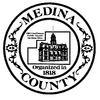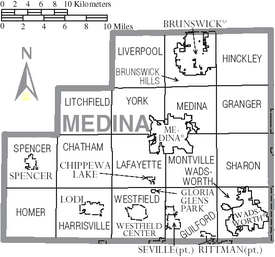Medina County, Ohio facts for kids
Quick facts for kids
Medina County
|
|||
|---|---|---|---|
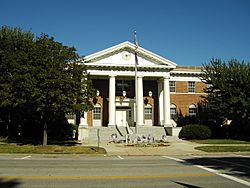
Medina County Courthouse
|
|||
|
|||
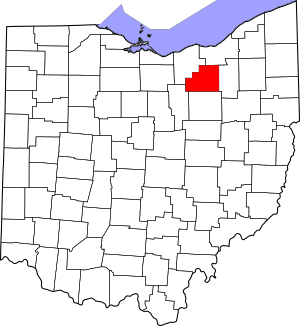
Location within the U.S. state of Ohio
|
|||
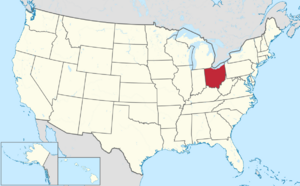 Ohio's location within the U.S. |
|||
| Country | |||
| State | |||
| Founded | 1812 (incorporated in 1818) | ||
| Named for | Medina, Saudi Arabia | ||
| Seat | Medina | ||
| Largest city | Brunswick | ||
| Area | |||
| • Total | 423 sq mi (1,100 km2) | ||
| • Land | 421.3 sq mi (1,091 km2) | ||
| • Water | 1.7 sq mi (4 km2) 0.4%% | ||
| Population
(2020)
|
|||
| • Total | 182,470 | ||
| • Estimate
(2021)
|
183,092 |
||
| • Density | 431.4/sq mi (166.55/km2) | ||
| Time zone | UTC−5 (Eastern) | ||
| • Summer (DST) | UTC−4 (EDT) | ||
| Congressional district | 7th | ||
Medina County (say it: muh-DYE-nuh) is a county in the state of Ohio. In 2020, about 182,470 people lived here. The main town, or county seat, is Medina. The biggest city in the county is Brunswick.
Medina County was created in 1812 and officially started in 1818. It was named after Medina, a city in Saudi Arabia. Medina County is part of the larger Cleveland area. Some parts of the county are also close to the city of Akron.
Contents
History of Medina County
Before Europeans arrived, different Native American tribes lived in what is now northeastern Ohio.
Later, the land became part of a French colony called Canada. In 1763, the land was given to Great Britain. It was then called the Province of Quebec.
In the late 1700s, this area became part of the Connecticut Western Reserve. This was a piece of land claimed by the state of Connecticut. In 1795, the Connecticut Land Company bought this land.
In 1852, a religious group called the German Baptist Brethren started a community here. It was known as the Black River Colony. They focused on living a very religious life.
Geography of Medina County
Medina County covers about 423 square miles. Most of this area, about 421.3 square miles, is land. The rest, about 1.7 square miles, is water.
The Medina County Park District was started in 1965. It takes care of over 6,353 acres of land. This includes 18 different parks and trails for people to enjoy.
Neighboring Counties
Medina County shares borders with these other counties:
- Cuyahoga County (to the northeast)
- Summit County (to the east)
- Wayne County (to the south)
- Ashland County (to the southwest)
- Lorain County (to the northwest)
People of Medina County
| Historical population | |||
|---|---|---|---|
| Census | Pop. | %± | |
| 1820 | 3,082 | — | |
| 1830 | 7,560 | 145.3% | |
| 1840 | 18,352 | 142.8% | |
| 1850 | 24,441 | 33.2% | |
| 1860 | 22,517 | −7.9% | |
| 1870 | 20,092 | −10.8% | |
| 1880 | 21,453 | 6.8% | |
| 1890 | 21,742 | 1.3% | |
| 1900 | 21,958 | 1.0% | |
| 1910 | 23,598 | 7.5% | |
| 1920 | 26,067 | 10.5% | |
| 1930 | 29,677 | 13.8% | |
| 1940 | 33,034 | 11.3% | |
| 1950 | 40,417 | 22.3% | |
| 1960 | 65,315 | 61.6% | |
| 1970 | 82,717 | 26.6% | |
| 1980 | 113,150 | 36.8% | |
| 1990 | 122,354 | 8.1% | |
| 2000 | 151,095 | 23.5% | |
| 2010 | 172,332 | 14.1% | |
| 2020 | 182,470 | 5.9% | |
| 2021 (est.) | 183,092 | 6.2% | |
| U.S. Decennial Census 1790-1960 1900-1990 1990-2000 2010-2020 |
|||
In 2010, there were 172,332 people living in Medina County. There were 65,143 households, which are groups of people living together.
Most people in the county were white (96.1%). About 1.2% were Black or African American, and 1.0% were Asian. People of Hispanic or Latino background made up 1.6% of the population.
Many families in Medina County had children under 18 living with them (35.3%). Most households (61.5%) were married couples. The average age of people in the county was 40.4 years old.
Economy of Medina County
Many different businesses and organizations provide jobs in Medina County. Here are some of the top employers in the county:
| Employer | Employees (2020) |
Employees (2011) |
Employees (2003) |
|---|---|---|---|
| Westfield Insurance | 2,040 | 1,560 | 1,292 |
| Cleveland Clinic–Medina Hospital | 1,431 | 886 | 920 |
| Medina County Government | 1,365 | 1,404 | 1,600 |
| Brunswick City School District | 834 | 836 | 850 |
| MTD Products | 781 | 680 | 2,190 |
| Medina City School District | 759 | 700 | 780 |
| Sandridge Food Corporation | 569 | 475 | NR |
| Discount Drug Mart | 509 | NR | 2,600 |
| Wadsworth City School District | 479 | 500 | NR |
| Carlisle Brake and Friction | 400 | NR | NR |
| Wellman Products Group | NR | 440 | NR |
| Shiloh Industries, Inc. | NR | 411 | NR |
| Plastik Pak | NR | NR | 1,467 |
| Schneider National | NR | NR | 800 |
| Friction Products/Hawk | NR | NR | 557 |
Communities in Medina County
Medina County has several different types of communities:
Cities
- Brunswick (This is the largest city.)
- Medina (This is where the county government is located.)
- Rittman (Only part of this city is in Medina County.)
- Wadsworth
Villages
- Chippewa Lake
- Creston (Only part of this village is in Medina County.)
- Gloria Glens Park
- Lodi
- Seville
- Spencer
- Westfield Center
Townships
- Brunswick Hills
- Chatham
- Granger
- Guilford
- Harrisville
- Hinckley
- Homer
- Lafayette
- Litchfield
- Liverpool
- Medina
- Montville
- Sharon
- Spencer
- Wadsworth
- Westfield
- York
Census-Designated Place
Unincorporated Communities
These are smaller communities that are not officially cities or villages.
Notable People from Medina County
Many interesting people have come from Medina County. Here are a few:
- Julia Carter Aldrich (1834–1914) – An author and editor from the 1800s.
- William G. Batchelder (1942–2022) – He was a Speaker of the Ohio House of Representatives.
- Alice M. Batchelder (born 1944) – A federal judge.
- Martin (1845–1919) and Anna (1846–1888) Bates – They were known as the tallest married couple.
- Connor Cook (born 1993) – A former NFL quarterback. He also played for the Michigan State Spartans.
- R. Sheldon Duecker (born 1940) – A bishop in the United Methodist Church.
- Jobie Hughes (born 1980) – One of the authors of the Lorien Legacies book series.
- Mark Hunter (born 1977) – A photographer and the lead singer of the heavy metal band Chimaira.
- Kyle Juszczyk (born 1991) – A fullback for the San Francisco 49ers football team.
- Lorin Morgan-Richards (born 1975) – An author and illustrator, known for children's books.
- Larry Obhof (born 1977) – An attorney and former President of the Ohio Senate.
- Matthew "MatPat" Patrick (born 1986) – A popular Internet personality.
- Pete Rademacher (1928–2020) – An Olympic boxer.
- Amos Root (1839–1923) – He created new ways to keep bees in the United States in the mid-1800s.
See also
 In Spanish: Condado de Medina (Ohio) para niños
In Spanish: Condado de Medina (Ohio) para niños



